Posts By rhonigolden
The spiral of grief
Shortly after Lena was born, I went through a psychological rough patch. I decided that I needed to see a professional to help me sort out what was going on. I wasn’t sure if I had post-pardom depression or if the severity of Gray’s condition was just sinking in. I only knew that, as a fundamentally happy person, I was not feeling like myself. I felt frustrated, helpless and irritated with those who were closest to me. I remember telling Barry about my decision to seek counseling and his reaction. “That sounds like a GREAT idea! I’m sure you could really benefit from some objective advice.” So, clearly I wasn’t doing a very good job of keeping my feelings to myself. I made an appointment with a psychologist the next day.
 I found my time with that therapist to be very enlightening. One of the things that she explained to me was called the “spiral of grief.” She drew a picture of a tornado-like spiral that was small at the bottom and large at the top. She told me to imagine my worst feelings of despair and frustration and loss and imagine that they were a wall next to the spiral (picture a vertical line to the right of the tornado).
I found my time with that therapist to be very enlightening. One of the things that she explained to me was called the “spiral of grief.” She drew a picture of a tornado-like spiral that was small at the bottom and large at the top. She told me to imagine my worst feelings of despair and frustration and loss and imagine that they were a wall next to the spiral (picture a vertical line to the right of the tornado).
So, the person who is experiencing the grief gets sucked up into the bottom of the spiral where the coil is tight and the revolutions are small. This causes the person to get slammed up into the wall over and over again in a very short time frame. This would be like when someone first gets devastating news. It can be hard to make it through even a day because the grief is so overwhelming and powerful. There may be short moments of normalcy or distraction, but they are quickly overshadowed by thoughts of the terrible situation at hand. Fortunately, as time goes on, we move our way up the spiral and the coil gets looser. It takes longer and longer amounts of time to travel around the spiral before hitting the wall again. We can go days, weeks and months without thinking about the grief. Additionally, the time between encounters with “the wall” is a chance to repair, get stronger and develop some perspective. It gives us time to do productive things that actually improve the situation instead of lamenting what we have lost or never had. That way, the next time the wall is swinging towards us, the impact is less jarring.
I think I have moved pretty far up the spiral at this point. Yes, there are days when I could burst into tears at any moment. But, those days are pretty rare at this point. As time goes on, I grow more and more comfortable with Gray’s autism and the prospects that it brings for our future. In fact, I think less about the future now than I used to. I believe that grief is something that can bog us down when we are unable to imagine our futures given our current situation. I’ve gotten more comfortable with the fact that I cannot control the future. And, I have gotten more comfortable with the fact that everyone’s future likely contains some pain and suffering. It’s inevitable that you and me and all of our children will encounter hardship of some kind. Although we can’t protect anyone from the future, we can insulate everyone. I believe that enjoying our present days and making good memories are the only way to battle grief and climb up out of the spiral.
Yes, Gray has lots of therapy each day after school and on the weekends. I hope that his therapy will help him to function better in the future, but I am not going to wring my hands about what might happen if he doesn’t get better. Instead, I will enjoy the free time that I have while Gray is in therapy and I will celebrate each little gain and prideful smile that he gives me when he learns some new skill there. Yes, I went to incredible lengths to get a service dog and now my son is attached to a canine billboard that announces his disability to the world. But, the improvement that dog has brought to our quality of life every day is worth any discomfort or extra effort that comes along with her. Yes, I have met with a financial advisor to make a plan for Gray’s future assuming he will always need care provided for him. I did not do this because I am giving up on him, I did this because I know that grieving over Gray’s condition and praying for a different outcome does not serve any of us. I did this so that I won’t be afraid of the future…it is secure no matter how Gray’s abilities improve or don’t.
So here is my message to fellow parents in my situation: If you are down in the bottom of the spiral, look up. It may be painful and disorienting as you wade through the endless evaluations and research different therapies and compare your child to other typical ones, but it will get easier over time. If you are closer to the top of the spiral and you find yourself “hitting the wall” because something happened today that reminded you of how impaired your child really is or made you fear for the future, you should know that the trip around the spiral is longer these days and you will bounce back faster than you imagined.
People often send me encouraging clips with video’s of kids and adults who have overcome the challenges presented by autism and now have something incredible to say. They send me stories about famous people with autism who made a mark on the world despite their awkward social skills or speech deficits. I know that these people mean well and are trying to offer me comfort and hope. But, the truth is, I don’t really need comfort or hope. I no longer mourn the loss of the son I thought I might have. Now, I can really enjoy Gray for who he is.
Halloween 2013
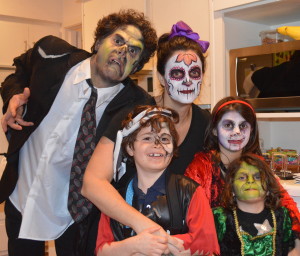 As I have mentioned in previous posts, like Halloween Past and Future, this is probably our most favorite holiday of the year. I guess it would be the epitome of having fun with your kids, right? That must explain why school, therapists and family put so much emphasis on practicing trick-or-treating skills. This year, one of Gray’s therapists had the brilliant idea to visit some of the houses where we would be visiting before the trick-or-treating began. While we all got ready to go, she ran ahead and brought treats that Gray would like. She explained our situation and asked them if they would let Gray finish his trick-or-treat requests on his iPad before they dropped one of our planted treats in his bag. Of course, everyone was happy to help us out.
As I have mentioned in previous posts, like Halloween Past and Future, this is probably our most favorite holiday of the year. I guess it would be the epitome of having fun with your kids, right? That must explain why school, therapists and family put so much emphasis on practicing trick-or-treating skills. This year, one of Gray’s therapists had the brilliant idea to visit some of the houses where we would be visiting before the trick-or-treating began. While we all got ready to go, she ran ahead and brought treats that Gray would like. She explained our situation and asked them if they would let Gray finish his trick-or-treat requests on his iPad before they dropped one of our planted treats in his bag. Of course, everyone was happy to help us out.
She returned to the house to find us still getting ready with face paint and dinner. Since Barry and I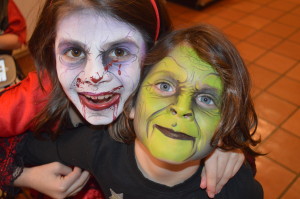 went all-out this year, I was curious to see how Gray would react to us in full face paint. I suspect that a lot of kids with autism might be unnerved by seeing their parents transform into something scary. Surprisingly, Gray thought it was hilarious. He kept gazing at us and touching our faces. In fact, when the makeup chair was empty, Gray climbed right up and tolerated a little face painting himself.
went all-out this year, I was curious to see how Gray would react to us in full face paint. I suspect that a lot of kids with autism might be unnerved by seeing their parents transform into something scary. Surprisingly, Gray thought it was hilarious. He kept gazing at us and touching our faces. In fact, when the makeup chair was empty, Gray climbed right up and tolerated a little face painting himself.
By the time that the “Big Event” was set to start, I felt completely relaxed and confident that the night would continue to be a big success. Hope patiently allowed us to strap a black cape over her service pack and Gray practiced pushing the button on his iPad that said, “My dog is a vampire.” Like so many other events over the last few months, Gray was able to participate fully in this event and his face 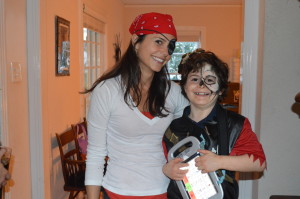 reflected nothing but pure pleasure. He walked nicely to the houses, used his iPad like a champ and happily opened his bag for the salty crunchy snacks that people put inside. Between houses, he beamed with pride. I swear, I could hear his little brain saying, “this is the coolest night EVER!”
reflected nothing but pure pleasure. He walked nicely to the houses, used his iPad like a champ and happily opened his bag for the salty crunchy snacks that people put inside. Between houses, he beamed with pride. I swear, I could hear his little brain saying, “this is the coolest night EVER!”
What else can I say? Fabulous night. Fun for all. One more big event that I can officially move from the “stressful column” to the “highly anticipated column.”
The Book that Blew My Mind
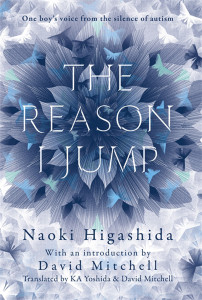 It is not uncommon for people to send me various newspaper articles or You Tube videos with subjects that pertain to autism. Usually, they are meant to be inspirational or share information about a new treatment option. While these bits of information are nice to receive and show great thoughtfulness on the part of the sender, they rarely give me any information that I find to be new or helpful. So, it was with a sweet smile that I read the email that a close friend sent to me. Her mother had seen a segment on Jon Stewart’s Daily Show and she had asked my friend to send along the information to me. Here is the segment that was on The Daily Show.
It is not uncommon for people to send me various newspaper articles or You Tube videos with subjects that pertain to autism. Usually, they are meant to be inspirational or share information about a new treatment option. While these bits of information are nice to receive and show great thoughtfulness on the part of the sender, they rarely give me any information that I find to be new or helpful. So, it was with a sweet smile that I read the email that a close friend sent to me. Her mother had seen a segment on Jon Stewart’s Daily Show and she had asked my friend to send along the information to me. Here is the segment that was on The Daily Show.
After watching that clip, I immediately got on Amazon to order the book. I decided to get the audio version so I could listen to it on my walks with Hope. As Mr. Mitchell so eloquently describes in the forward, we autism parents read a lot of books about autism. The problem is that they are all written by non-autistic people. They are third person observations and what we autism parents REALLY want to hear is a first person experience. The closest thing I have found, until now, is the writings from Dr. Temple Grandin. I know that her work has been very meaningful for many people, but her autism is very different from Gray’s autism. Her words might offer a glimpse into the autism experience, but they never really felt like they aligned with the experience in my home.
Naoki, on the other hand, sounds very much like my son. I could weep at the excitement that comes from getting a glimpse into that boy’s mind. I have tried to remember that the account of a 13-year-old boy who lives in Japan will obviously be different from my 7-year-old in Texas, but it is hard to keep myself from closing my eyes and imagining these writings as Gray’s own thoughts.
The book is written largely in question and answer format. Here are 2 of the questions that had a big impact on me:
Do you prefer to be on your own?
I can’t believe that anyone born as a human being really wants to be left all on their own. What we’re anxious about is that we’re causing trouble for the rest of you, or even getting on your nerves. This is why it’s hard for us to stay around other people. The truth is, we’d love to be with other people. But because things never, ever go right, we end up getting used to being alone. Whenever I overhear someone remark how much I prefer being on my own, it makes me feel desperately lonely. It’s as if they’re deliberately giving me the cold shoulder.
Why do you get lost so often?
I’ve already mentioned how I dash off as soon as I spot anything interesting. There’s a different reason for why we get lost so often, however; and I think it’s this: We don’t really know where we ought to be. You could tell us that we ought to follow someone else, or hold their hand. But the fact is that, with or without your suggestion, we are still going to lose our way. Simply put, people with autism never ever, feel at ease wherever we are. Because of this, we wander off, or run away in search of some location where we do feel at ease. While we’re on this search, it doesn’t occur to us to consider how or where we’re going to end up. We get swallowed up by the illusion that, unless we can find a place to belong, we are going to be all alone in the world. Then, eventually, we get lost and have to be escorted back to the place where we were at or the person we were with before. But our uneasy unsettled feeling doesn’t go away. I don’t think we’ll ever be able to reach our Shangri-la, however. I know it exists only in the depths of the forest or at the bottom of the deep blue sea.
While there are parts of the book that are just heartbreaking, these 2 answered questions give me great comfort in the way we have adapted our lives and our family to include Gray and his disability. I know I have said it a million times, but this book just proves that what I suspected was true. Gray was difficult in public because he felt the same way as Naoki describes. With Hope, I believe that Gray finally feels at ease. He no longer feels that urge to run off in search of the place where he belongs. He know he belongs with Hope. Because of Hope, Gray is not left alone. Because of her, Gray can be with us whenever we go ANYWHERE and it is not a disaster. It is a joy. It is joyful because he is with us. And, the gratitude shows on his little face when he looks expectantly out of the car window wherever we go.
If you’re still not sure about whether the book is worth reading or not, watch Part 2 of the interview on The Daily Show.
The State Fair of Texas

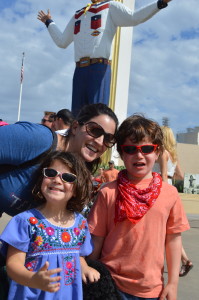 Last Sunday, the weather was beautiful. I spent the whole weekend looking for ways to be outside. On a whim, I decided that we should take the kids to the fair for a few hours. The fair is close to our house, we had no other plans, why not just make an impromptu trip?
Last Sunday, the weather was beautiful. I spent the whole weekend looking for ways to be outside. On a whim, I decided that we should take the kids to the fair for a few hours. The fair is close to our house, we had no other plans, why not just make an impromptu trip?
Well, last year, I would have told you that the very idea of taking Gray to the fair was utter madness. There would have been no way on the planet that anyone could convince me that it would be at all fun. I know that, at a minimum, I would have a screaming flailing child that I would have to scoop up off of the ground in a crowded walkway or animal exhibit. There would have also been the very real possibility of just losing him in the crowd. I could envision myself in front of the reporters trying to explain what would possess a mother to take a child such as mine to a place such as the fair — all while a search team scoured the area. No thank you. The fair did not happen last year.
But, this year was dramatically different. The fair just sounded like a good way to kill a few hours on a Sunday afternoon. It wasn’t until we got to the fair and started looking for parking that I really realized how amazing it was to be there with Gray. It almost didn’t cross my mind that this was something to appreciate. THAT is how our life feels now: Much closer to normal than I ever dreamed possible.
Truthfully, I don’t even have anything that interesting to say about last Sunday except that we went to the fair, we ate some fried food, we watched a pig race and the kids got whiny after about 3 hours, so we left. It was so easy that, when Zoe and Gray had the day off of school on Friday, I made another last-minute decision to take them to the fair for another 3-hour go ’round.
race and the kids got whiny after about 3 hours, so we left. It was so easy that, when Zoe and Gray had the day off of school on Friday, I made another last-minute decision to take them to the fair for another 3-hour go ’round.
Our second trip was equally pleasant. As we walked around, we stopped so that Zoe could go on the bigger rides. I figured that we would make our way over to the kiddie rides so that Gray could enjoy some as well. Even though he seems like a thrill seeker, I felt nervous putting him on rides that were meant for kids his age. I explained to Zoe that I was concerned that if Gray got upset or tried to get out of his seat, she would not be big enough to control him. Of course, I was not going to go on any bigger riders with him. I needed to stay with Hope and my post-40-year-old vestibular system couldn’t take it anyway. So, Zoe and I checked out various rides that looked like they might be possibilities for Gray. We stopped at one ride that looked like a spinning octopus with spinning pods at the ends of the tentacles. Gray stood at the fence and watched the ride go around while Zoe and I discussed the safety harnesses. In the end, we both decided that it was probably too much for Gray. We turned to move on, but Gray pulled back and started whining. I pulled out the iPad and asked him what was wrong. He opened up his communication app and pressed “Fun” -> “Leisure” -> “Ride Bike.” Then, he pointed to the ride. Zoe and I looked at each other in amazement. There are not any amusement park choices on Gray’s iPad, so he just came up with the closest thing.
Minutes later, I was strapping him into the octopus pod. He was genuinely happy and gave no protest when the safety bar came down over his chest and across his lap. I asked the ride operator if there was an emergency stop switch. He assured me that there was, but looked very uneasy that the lady with her kid strapped to a dog was asking about emergency plans. When the ride took off, Gray was the happiest kid at the whole fair. Zoe got him to raise his arms and squeal and he did it over and over again with each passing spin.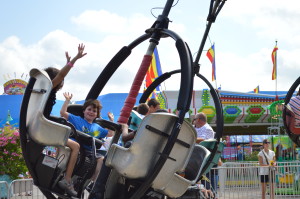

After the ride was over, we went for more fried food. Zoe walked with her arm draped over her brother’s neck. “I’m so proud of you, buddy! You’re my best friend in the whole world!” Then, she looked at me and said, “I’m so glad that Gray is just the way he is. A normal brother would be a bratty pain-in-the-neck, but my brother is the sweetest one around. I definitely would not trade him for any other brother.”
Me neither, Zoe.
How time flies
 This weekend carries great significance for the Golden family. The first couple of weekends of October are always focused on decorating for Halloween. Because we are Jewish, we don’t decorate for Christmas and our Hanukkah decorations are somewhat sparse. Halloween is our big decorating holiday. It’s a very big holiday in our neighborhood and Barry feels passionately about decorating the house to the point of overkill. Each October, we pull out the boxes of Halloween decorations and costumes from years passed.
This weekend carries great significance for the Golden family. The first couple of weekends of October are always focused on decorating for Halloween. Because we are Jewish, we don’t decorate for Christmas and our Hanukkah decorations are somewhat sparse. Halloween is our big decorating holiday. It’s a very big holiday in our neighborhood and Barry feels passionately about decorating the house to the point of overkill. Each October, we pull out the boxes of Halloween decorations and costumes from years passed.
This year, as we were sorting through the boxes, I realized that it was exactly 2 years ago when we submitted our application to ASDA. This was probably just a week or so after I had first learned of the existence of autism service dogs. I remember that this was the week we submitted our application because part of the application process required us to submit two videos. We had to take a video of our family at home and we had to have a video of Gray interacting with a dog or dogs. Stacking the decorations out in our dining room brought back the image of our video that I sent during our decoration process 2 years ago.
It is incredible to think about how much things have changed since I made those videos. As I listen to the sound of my own voice narrating, I can remember how hopeful I was that a service dog would make a difference for Gray and our family. As time passed over the 15 months that we had to wait for Hope, I can say that my anticipation moved from unreasonably optimistic to completely skeptical and back again in a cycle that probably didn’t end until about 2 weeks after I brought Hope home from Portland.
I often say that I wish I had a crystal ball so that I could just have a little glimpse of how things will turn out for Gray. Today, I wish I could be the vision in the crystal ball so I could go back and tell that 2-years-ago version of myself what to expect. I would tell her that things are going to first get a lot worse. I would tell her that there are going to be some scary moments with Gray’s mania and self-injurious behavior and running out into traffic and ruined family outings. I would tell her that she will have moments of feeling overwhelmed and unsure of how she will even make it through a day let alone her whole future. And then, I would tell her that it is going to get so much better. I would tell her that she made such a brave and smart decision in leaping head-first into the service dog decision. I would tell her that things are going to get so much better that she will be inspired to write about it so that other people can find out about this life-changing and game-changing possibility for their child.
I know I will never have a crystal ball, but knowing that the story I would share with my younger self has such a happy ending gives me peace. I’m certain that there are tough times and decisions ahead, but I have learned to trust my instincts.
For your viewing enjoyment: This first video is the family at home decorating for Halloween. Zoe is 7, Gray is 5 and Lena is 2.
And, our day at the dog park. Gray is much more interested in the other people than the other dogs.
Insurance companies are evil Part 2
On April 24, I wrote my Insurance companies are evil post discussing my frustration over getting Gray’s therapy paid. For the last month, I have been living through Part 2 of that story.
When last we left off, Gray’s behavioral therapy hours had been cut back from 20 per week to 15. That was a loss, but it only lasted for a short while because we were able to get more hours approved for the summer when he was out of school. Concurrently, I was told that our insurance carrier was not going to continue their individual contract with my therapist. As I detailed in my post on April 24, I won that battle. We were given a 6-month extension of our therapist’s contract and she was encouraged to apply for in-network status.
As our glorious summer came to a close, I started thinking about the renewal of Gray’s treatment plan that was do mid-September. Our therapist began the process of applying for in-network status with our insurance company at the end of July. Unfortunately, we quickly found out that was not enough time to complete the process. We were told that the process generally took many months. I was stressed, after spending the required $10K out-of-pocket on in-network providers, all of Gray’s therapies have been getting paid at 100%. On the other hand, our out-of-network benefits require us to spend an additional $20K out-of-pocket before the insurance will pay for any portion of our bills. At a rate of approximately $1,500 per month, you can understand why it is important to me to keep our therapists in-network.
Gray’s therapist furiously submitted the required information and begged anyone she could to fast-track her application. Fortunately, it has been going much quicker than anyone expected, just not quick enough. As the September re-authorization date came and went, his therapist’s in-network status remains in process. I spoke with our autism care advocate at the insurance company and the conversation quickly headed down the same road as the one that we had in April. I asked for a short extension of our therapist’s contract, she said it would not be possible, I asked to speak with her supervisor, she said she would pass on the message…same story different month. After speaking with her (yet unnamed) supervisor, she told me that my only option was to file a letter of appeal with the appeals department. I asked her if she thought that would be productive and she said she had no idea.
Then, things got a little weird. I already had the name and phone number for her supervisor because I had found it back in April through my amazing sleuth-skills. Rule number 1 for parents in my situation: always keep a record of who you have spoken with, their position and their direct extension. So, I left a message for our advocate’s supervisor giving a brief explanation of our situation. I told her that I knew she wanted us to file an appeal, but I would really appreciate the opportunity to speak with her personally. I got no response. I left another message the next day. Then, I got a call from our advocate who said that her supervisor had received my message and told her to call me and say that my only option was to file a letter of appeal. I asked her if she would ask the supervisor to call me. After a couple of days, I called the supervisor and left another message. This dance went on for about 2 weeks. I would leave 2 or 3 messages for the supervisor and then her subordinate would call me to say that my only option was to file an appeal. It was maddening. When I asked our advocate why her supervisor would not call me herself, she said she did not know. When I asked her if she thought that was strange, she just said that I was making her uncomfortable. Fair enough. I hung up the phone with her and called the main number to start hunting down the supervisor’s supervisor (the grand-supervisor, if you will).
One hour and 3 call-transfers later, I was on the line with an unspecified person who claimed to be able to access the supervisors, but would not grant me access. She said, “I guess I don’t understand why you don’t just do as you’re told and file an appeal.” Well, my first thought was, “It’s not for you to understand. You have no authority to affect this situation either way, so I don’t really care what your thoughts are on the matter.” Of course, I did not say that. What I said was, “as the mother of a child with severe autism, I don’t have a lot of spare time to draft letters with my therapists and send them off to some unknown place where they may or may not be read or answered. I would rather speak with someone who knows this case so we can have a productive conversation.” Her response was astounding.
“Ma’am, you can CALL and CALL and CALL and CALL and CALL, but the answer is still going to be the same. File and appeal and stop trying to talk to supervisors.” Once again, I was brought back to the film that I referenced in my Insurance companies are evil post from April. During the trial, the mother of an ill child reads a letter from her insurance company in response to her repeated phone calls. The letter says, “you must be stupid, stupid, stupid.” I’m pretty sure that was the same thing that this insurance representative was saying to me. She thought I was being stupid, stupid, stupid. She was wrong. I calmly asked to be put into the voicemail of the grand-supervisor. She complied. That gave me the name of this mysterious wizard behind the curtain and I was able to use my super-sleuth skills to figure out her email address. Here is the email that I sent to her:
Good morning Dr. Hxxxxs,
I left a message for you yesterday after spending a very frustrating 40 minutes on the phone with a UBH representative who did not want to allow me to contact you. Here are the issues that I would like to discuss with you:
1. My 7-year-old son, Gray, is severely autistic. He is non-verbal, not fully toilet trained and has many behavioral challenges. I have been very fortunate to find an excellent BCBA who contracts with truly gifted therapists. Together, they have made some wonderful gains with my son over the last year. Until last March, my son’s BCBA has worked with Gray under an individually negotiated contract with UBH. Last March, when his approval was up for renewal, we were surprised to find that UBH would not continue their contract with Lxxxx. Fortunately, after much discussion, UBH agreed to extend her contract for another 6 months so that Lxxxx would be able to apply for in-network status.
2. Lxxxx began the application process at the end of July. Both of us thought that would be enough time to gain her status before his current authorization expired on September 18th. We were incorrect. Although she is VERY far along in the process and her audit is almost complete, she has not yet received her in-network status.
3. I spoke with Dr. Nxxxx, our autism care coordinator, to ask if we could have a short extension of Lxxxx’s contract to bridge the gap until her application is approved. Dr. Nxxxx told me that was not possible. I asked if I could speak with her supervisor about this and she told me that she would issue a request on my behalf. The next day, Dr. Nxxxx called me back to tell me that her supervisor, Dr. Hxxxx, said that my only option was to write a letter along with our BCBA and send it to the appeals office. I asked Dr. Nxxxx if she believed that this would be an effective option in getting our claims paid at in-network rates. She said that she did not know because she had never seen an appeal for this kind of issue before. This option is not very appealing to me because I am very skeptical that it will be effective at all. As a mother of 3 children with one being severely autistic, I do not have time to compose and file paperwork unless I am certain that is will be a worth while endeavor.
4. Because Dr. Nxxxx told me that she was not authorized to do anything other than offer me the appeals information, I decided to contact her supervisor, Dr. Hxxx. I know from our experience back in March that Dr. Hxxxx, unlike Dr. Nxxxx, has the authority to extend Lxxxx’s contract. I have left several messages for Dr. Hxxxx on her voicemail asking her to contact me in hopes that we could discuss our situation. Dr. Hxxxx has never returned any of my calls or directly contacted me in any way. Instead, she has asked Dr. Nxxxx to call me and reiterate the message that my only recourse is to file an appeal. I asked Dr. Nxxxx why Dr. Hxxxx would not speak with me directly and she said that she did not know, but could only give me the message that Dr. Hxxxx had passed along.
This is why I am now attempting to contact you, Dr. Hxxxx. As a customer of United Healthcare who is in good standing, I feel that I am receiving poor customer service. As a mother of a child with a severe disability, I feel that I am being treated in a callous and unsympathetic manner. At a minimum, Dr. Hxxxx should make the time to contact me directly and listen to my request. Her manner of responsiveness is insulting and unacceptable. Additionally, I do not feel that I am making an unreasonable request. My son’s BCBA is very qualified and has all of her credentials in order. I have no doubt that she will be approved for in-network status. By extending her individual contract for the brief period of time that it will take to get her approval in order (perhaps 12 weeks), this will prevent me from having to cancel my son’s therapy sessions or pay $2000-$3000 out of pocket to bridge the gap in coverage. It is not beneath me to beg on behalf of my son and his therapy treatments. He has been making very promising gains in ABA therapy over the last few months and it would undoubtably be detrimental for him to stop those services. I would also like to add that Lxxxx has reported that the contracted in-network rates that she will be receiving from UBH once she is approved is actually a bit higher than the individually contracted rates that she has been receiving. Therefore, it would not cost UBH any extra money to extend the contract with Lxxxx.
I would be extremely grateful if you would contact me directly so that we may discuss the possibility of just one more extension of Lxxxx’s individual contract so that my son may continue his therapy without interruption or undue financial hardship on my family. Please respond to this email or call me at your earliest convenience.
Sincerely,
Rhoni Golden
The grand-supervisor called me 10 minutes after I sent this email. She was as nice and friendly as she could be. She asked for the information to contact Gray’s therapist and said that she would set up a phone call ASAP. She said that she would do her best to help us because our request seemed reasonable. Four days later, she overturned the denial of our therapist’s contract and approved the extension. I’m back to paying nothing out of pocket through the end of the year.
The moral of the story:
Don’t give up. Don’t take negative outcomes from subordinates. I don’t think that the grand-supervisor was intimidated or annoyed my be. I think she genuinely saw my point and wanted to be helpful. The trick was climbing over all of the other obstacle-people who were thrown in my way.
House guests
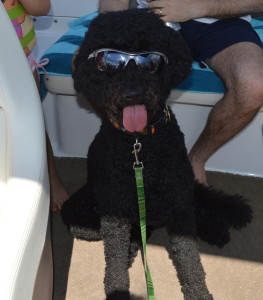 The last time that we took a family road trip and stayed with friends, was two years ago. We drove to Austin to stay with one of my closest friends from childhood and her family. Although the weekend went fairly well, in my opinion, my friend couldn’t help but remark about how difficult our lives looked. “You don’t get any down time, do you?” I remember that question vividly because it made such an impression on me. I remember thinking that she was right. The only time I had for “down time” was when Gray was under the care of someone else. Otherwise, it was non-stop movement and monitoring to make sure that he didn’t destroy things or go missing. To cap it all off, we ended that weekend with a trip to the emergency room.
The last time that we took a family road trip and stayed with friends, was two years ago. We drove to Austin to stay with one of my closest friends from childhood and her family. Although the weekend went fairly well, in my opinion, my friend couldn’t help but remark about how difficult our lives looked. “You don’t get any down time, do you?” I remember that question vividly because it made such an impression on me. I remember thinking that she was right. The only time I had for “down time” was when Gray was under the care of someone else. Otherwise, it was non-stop movement and monitoring to make sure that he didn’t destroy things or go missing. To cap it all off, we ended that weekend with a trip to the emergency room.
On Sunday morning, as were finishing breakfast and packing up to go, Gray fell on the stairs and sliced his chin open on the bottom of the railing. At first I didn’t realize how badly he was hurt because it didn’t bleed very much. The only notable thing about the fall was that, after crying and getting up, he ran to me and threw himself in my arms. He had never done that before. I think that is fairly common among kids who have autism: they don’t seek comfort from other people. I remember feeling encouraged that he had come to me for comfort. It wasn’t until a few minutes later that I realized how bad the injury was and that he was going to require stitches. That made me consider the idea that perhaps children with autism don’t seek comfort as much because they don’t feel pain as easily. Gray has an unusually high pain tolerance. He can punch himself in the legs until they bruise, he can bite his arm until it bleeds and he can smash his head into a wall until his forehead splits open. I guess it only makes sense that it would take an emergency-room-worthy injury to be painful enough for him to seek comfort from me.
 To make a long story short, instead of leaving at noon on that Sunday, we left around 6pm. I spent the day in the hospital with Gray while Barry and the girls stayed back at my friends house. Needless to say, we went to bed Sunday night feeling drained from our weekend instead of rejuvenated by the little getaway. I’m certain that my friend and her family felt the same way.
To make a long story short, instead of leaving at noon on that Sunday, we left around 6pm. I spent the day in the hospital with Gray while Barry and the girls stayed back at my friends house. Needless to say, we went to bed Sunday night feeling drained from our weekend instead of rejuvenated by the little getaway. I’m certain that my friend and her family felt the same way.
Of course, now that we have Hope and I have been documenting all of our success stories, our appeal as house guests has returned. After our successful trips over the summer, I felt confident in accepting the invitation that my friend extended for us to come try again.
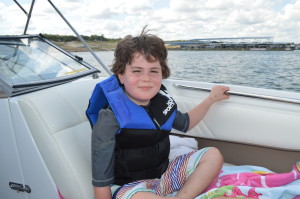 In a nutshell, the weekend was a smashing success.
In a nutshell, the weekend was a smashing success.
After an uneventful 3 1/2-hour drive, we arrived around 7:30. Lena and Zoe flew out of the car to play with the other kids. Gray had fallen asleep, but woke up while we were unloading and happily joined everyone in the house. At first, Gray just sat at the table with the grown-ups while we chatted and the kids played upstairs. I told my friend that the goal for the weekend was to “achieve down-time”. I was feeling optimistic because Gray has been on the low end of the energy/mania spectrum these days. After about 20 minutes of listening to the other 4 kids screaming and playing above us, Gray jumped up and headed up the stairs to join them. I followed to see what kind of destruction he might have in mind.

 Because Gray doesn’t really know how to play with other kids, he often just picks up on the energy in the room and will get revved up by the activity around him. This can look like jumping, squealing, pulling kids’ hair, pinching, or having a bathroom accident. Generally, Lena and Zoe can roll with this and help Gray engage in a more appropriate fashion or, at a minimum, they won’t be too distressed if they get assaulted. I couldn’t count on their help with 2 new friends to play with, though. Like a spy, I crept up the stairs and stayed about 20 feet behind Gray so he wouldn’t notice I was tailing him. I peeked around the corner to the playroom and saw that the older kids were engaged in a full-on wrestling match while the younger two sat nearby on the floor playing with dolls. Gray was just standing in the middle of the room with a big smile on his face. I waited. That big smile usually means trouble is brewing. But, to my surprise, he eventually just went to sit down on the couch and watch the other kids playing. He was still smiling, but it looked more like the expression of someone who is enjoying a movie rather than a serial killer observing his next victim.
Because Gray doesn’t really know how to play with other kids, he often just picks up on the energy in the room and will get revved up by the activity around him. This can look like jumping, squealing, pulling kids’ hair, pinching, or having a bathroom accident. Generally, Lena and Zoe can roll with this and help Gray engage in a more appropriate fashion or, at a minimum, they won’t be too distressed if they get assaulted. I couldn’t count on their help with 2 new friends to play with, though. Like a spy, I crept up the stairs and stayed about 20 feet behind Gray so he wouldn’t notice I was tailing him. I peeked around the corner to the playroom and saw that the older kids were engaged in a full-on wrestling match while the younger two sat nearby on the floor playing with dolls. Gray was just standing in the middle of the room with a big smile on his face. I waited. That big smile usually means trouble is brewing. But, to my surprise, he eventually just went to sit down on the couch and watch the other kids playing. He was still smiling, but it looked more like the expression of someone who is enjoying a movie rather than a serial killer observing his next victim.
I went back downstairs feeling somewhat comfortable that I could re-join the grown-ups with little worry. For any other autism parents out there, I suspect that you can understand how huge a moment this was. First, to see Gray showing interest and pleasure in watching other kids play was a pretty big deal. Most kids with autism just tune-out other children. That’s part of why their social skill are so poor. I have to think that being a spectator in the stands is almost as good playing the sport, right? At least it’s a start. Second, I have long fantasized about being one of those moms who can sit and chat with other parents while our kids play. For any parents who only have typical children, you have no idea about the luxury you possess. Most families can accept last minute invitations to spend an afternoon or evening at another family’s house. The grown-ups get down-time while the kids wear themselves out. It’s a win-win for all parties. Most moms and dads can relax in these settings secure in the knowledge that their children will behave, more or less. That has never been my life. I will accept those invitations when I can for the sake of Zoe and Lena, but I always know that I will spend my time following Gray around and preventing disasters. This night felt like a dream come true. It felt like…DOWN TIME!

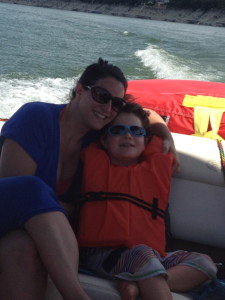 When we finally decided to get the kids to bed, I tried to get Gray down first. He is usually pretty easy to get to sleep in any setting because he works much more off of internal cues than external ones. I knew he was tired and I figured that, if I just went through his normal bedtime ritual, he would understand that he needed to go to sleep. While he was cooperative with the bedtime process and even lay in the bed without protest, he did not stay in the bed when I moved to leave the room. This surprised me. He just followed me out of the door. When I told him that it was time for night night, he just looked at me and shook his head. I led him back in the room and laid down next to him in the bed. Within minutes, he was sound asleep.
When we finally decided to get the kids to bed, I tried to get Gray down first. He is usually pretty easy to get to sleep in any setting because he works much more off of internal cues than external ones. I knew he was tired and I figured that, if I just went through his normal bedtime ritual, he would understand that he needed to go to sleep. While he was cooperative with the bedtime process and even lay in the bed without protest, he did not stay in the bed when I moved to leave the room. This surprised me. He just followed me out of the door. When I told him that it was time for night night, he just looked at me and shook his head. I led him back in the room and laid down next to him in the bed. Within minutes, he was sound asleep.
I came out to find the others getting ready for bed. I commented to my friend how I thought it was weird that he needed me with him before he fell asleep. To her, the reason was obvious: a kid in a strange place can have a hard time going to bed. Honestly, the thought never occurred to me. The more I thought about it, though, the more I knew she was right. This was another huge moment. At that moment, I put together what this evening meant: Gray was paying attention to his environment. Huge. Could it be that all of this community training with Hope was actually translating into other areas? It’s not such a crazy thought. Hope has taught Gray to slow down and observe his surroundings. She gives him comfort in being where he is supposed to be in the community and, I believe, this has helped him calm down overall. It only makes sense to think that this “therapy,” like all of his other therapies, is beginning to carry over to all aspects of his life.
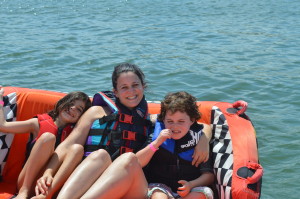 The next day was equally calm and pleasant. After a leisurely breakfast, our friends offered to take us out on their boat. After our initial success with Kati and her family on the river in Oregon, I felt very confident as we headed out to the lake. We spent six hours out on the lake. My friend’s husband proved to be an excellent captain and expert inner-tube pilot. All the kids took turns riding on the inner-tube behind the boat. Then, we threw down anchor at a little beach and everyone got out to swim — including Hope. She looked so funny paddling in the water, but when she reached the beach, she found 2 other dogs ready to play. While Hope ran in and out of the water, Gray enjoyed the squishy mud under his feet and feeling the sandy dirt in his hands. Of course, when he spotted other people on the beach with a picnic, he tried to make a break for them to score snacks, but he was easily redirected when I went after him. After swimming, we loaded back up on the boat and cruised over to a floating restaurant. Barry was amused by a “no animals” sign on the front of the restaurant. We were all a little tense that we might be in for an argument regarding Hope’s right to join us, but no one even gave us a second glance. We sat, we ate, we fed our leftovers to a mob of catfish. It was easy. The whole day was easy.
The next day was equally calm and pleasant. After a leisurely breakfast, our friends offered to take us out on their boat. After our initial success with Kati and her family on the river in Oregon, I felt very confident as we headed out to the lake. We spent six hours out on the lake. My friend’s husband proved to be an excellent captain and expert inner-tube pilot. All the kids took turns riding on the inner-tube behind the boat. Then, we threw down anchor at a little beach and everyone got out to swim — including Hope. She looked so funny paddling in the water, but when she reached the beach, she found 2 other dogs ready to play. While Hope ran in and out of the water, Gray enjoyed the squishy mud under his feet and feeling the sandy dirt in his hands. Of course, when he spotted other people on the beach with a picnic, he tried to make a break for them to score snacks, but he was easily redirected when I went after him. After swimming, we loaded back up on the boat and cruised over to a floating restaurant. Barry was amused by a “no animals” sign on the front of the restaurant. We were all a little tense that we might be in for an argument regarding Hope’s right to join us, but no one even gave us a second glance. We sat, we ate, we fed our leftovers to a mob of catfish. It was easy. The whole day was easy.
We loaded up on Sunday to head over to another friend’s house for lunch and swimming. By this point, I was feeling downright smug. On the drive back to Dallas, Zoe said, “This was the best weekend ever! This was much more fun than any big expensive vacation in the Caribbean. I bet we could afford 10 more trips like this for the price of 1 big vacation. Can we start doing this instead, Mom?”
Maybe we can, Zoe. We are a traveling bunch. Out of town friends: get your guest rooms ready.
Invisible Dog
I have mentioned before that I believe being transparent and sharing my situation helps me to live a happier life. Most people who know me also know lots of details about Gray and my family. I have come to take that on as a kind of identity. But, there are times when I find myself in places where it just isn’t necessary or appropriate to bring up that part of my life. For example, at Lena’s preschool, I am just a mom of another Pre-K kid. Of course, Gray and Hope have made appearances at her preschool since last February, but it is a pretty irregular occurrence. The teachers who have had Lena in their classrooms over the past 2 years know the situation, but most of the parents do not.
Over the last several months, I have become friendly with one of the moms in Lena’s class. Lena really enjoys playing with her daughter, and her mom and I have enjoyed chatting during their play dates. She and her husband own a restaurant and I really love having long conversations with them about food and cooking. Throughout high school and college, I waited tables and tended bar. In my downtime, I would hang out in the kitchen and pick up cooking tips from the chefs. I love food and I love cooking and I even miss waiting tables. So, it feels like a special treat to stand around at a birthday party or school function, watching my perfectly-normal 4-year-old play while I talk about restaurant gossip with other parents. It makes me feel like a typical parent…normal even! In fact, during a play date, I mentioned the article that ran in The Advocate Magazine to this mom and she had no idea about Gray or Hope.
Time and time again, I find myself surrounded by a group of moms and realizing that I feel like a have a double life. They are talking about subjects that mothers of typical kids discuss and I am left thinking, “if you only knew how different your life is from mine.” It can be refreshing, but it can also feel a little strange and disingenuous. I am hoping that, as we have more time and successful experiences with Gray, we can just start doing more things as a whole family without having to create a big fanfare around Gray and Hope. I envision a day when we can just show up places and blend in. It’s humorous, right? When I started this blog 7 months ago, I needed Hope to announce and explain Gray’s bizarre behavior. Now, I have moved on to Hope becoming less noticeable so that Gray’s new social skills can shine through.
 Last weekend, Lena was invited to a bowling birthday party for a kid in her class. Because it was scheduled at a time when no one in our family had other commitments, I decided to bring the whole family. None of my kids had ever been bowling before and I thought it would be fun to try this out as a family event. I called ahead and booked a lane next to the party so the rest of my crew could have a place to bowl without disturbing Lena and her friends. We made a social story for Gray on his iPad and off we went. On our way in from the parking lot, we met my mom-friend and her daughter. I introduced her to Gray and Hope and we all walked in together. Gray did
Last weekend, Lena was invited to a bowling birthday party for a kid in her class. Because it was scheduled at a time when no one in our family had other commitments, I decided to bring the whole family. None of my kids had ever been bowling before and I thought it would be fun to try this out as a family event. I called ahead and booked a lane next to the party so the rest of my crew could have a place to bowl without disturbing Lena and her friends. We made a social story for Gray on his iPad and off we went. On our way in from the parking lot, we met my mom-friend and her daughter. I introduced her to Gray and Hope and we all walked in together. Gray did  so well walking into the bowling alley and waited patiently while we got shoes for
so well walking into the bowling alley and waited patiently while we got shoes for 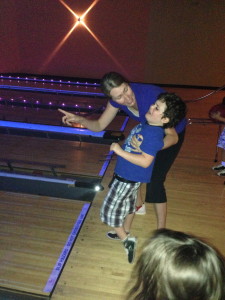 everyone and set up our things at the lane. When it was his turn to bowl, we unhooked his tether from Hope and walked him up to select a ball and throw it down the lane. Hope waited quietly under the table at our booth while her boy took his first shot at bowling. Gray didn’t care for the sport too much. He really wanted to accompany the ball down to the end where the pins were, and he was frustrated when we wouldn’t let him go. Nevertheless, his anger was fleeting and he happily returned to the booth where he sat with Hope and ate snacks. In between his turns, I sat in the booth and chatted with the moms on the other side where the party was going on. About an hour into the party, I thought to myself, “Does anyone notice that there is a DOG here with us?” I really don’t think that they did. Even the mom who walked in with us seemed to forget that there was anything unusual about the situation. We talked about the upcoming school year and kindergarten choices for next year and other typical 4-year-old mom topics.
everyone and set up our things at the lane. When it was his turn to bowl, we unhooked his tether from Hope and walked him up to select a ball and throw it down the lane. Hope waited quietly under the table at our booth while her boy took his first shot at bowling. Gray didn’t care for the sport too much. He really wanted to accompany the ball down to the end where the pins were, and he was frustrated when we wouldn’t let him go. Nevertheless, his anger was fleeting and he happily returned to the booth where he sat with Hope and ate snacks. In between his turns, I sat in the booth and chatted with the moms on the other side where the party was going on. About an hour into the party, I thought to myself, “Does anyone notice that there is a DOG here with us?” I really don’t think that they did. Even the mom who walked in with us seemed to forget that there was anything unusual about the situation. We talked about the upcoming school year and kindergarten choices for next year and other typical 4-year-old mom topics.
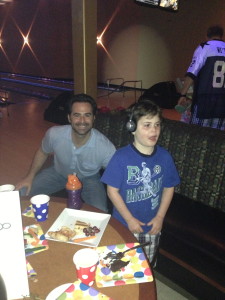
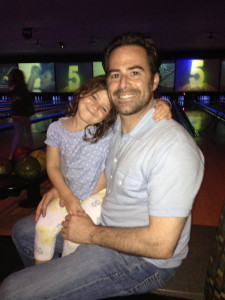
 When it was time to sing “Happy Birthday,” Gray popped up on his knees and grinned at the group singing his favorite song. At the end, he clapped and smiled. Then, he sat back down in the booth and happily accepted the pizza and snacks that were passed around. Through all of the chaos and noise, I sat and quietly marveled at how normal our family looked with our “invisible dog” who kept us in order. I had fretted over the decision to bring the whole family to this party and I had tried to consider a back-up plan for bailing out if things got rough with Gray. Sitting there at the party, the idea seemed ridiculous to me. The event was completely stress-free.
When it was time to sing “Happy Birthday,” Gray popped up on his knees and grinned at the group singing his favorite song. At the end, he clapped and smiled. Then, he sat back down in the booth and happily accepted the pizza and snacks that were passed around. Through all of the chaos and noise, I sat and quietly marveled at how normal our family looked with our “invisible dog” who kept us in order. I had fretted over the decision to bring the whole family to this party and I had tried to consider a back-up plan for bailing out if things got rough with Gray. Sitting there at the party, the idea seemed ridiculous to me. The event was completely stress-free.
When the party ended, Zoe and Lena asked if we could stay and visit the video arcade. We played games for over an hour while Hope sat on the floor 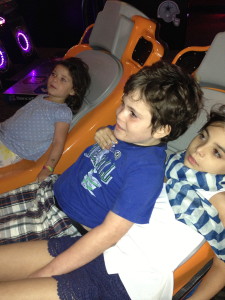 and watched all the action. All three kids enjoyed a simulated ride video game and Gray had a blast riding a motorcycle while I assisted with steering. Afterwards, we all loaded up in the car and drove to a sports bar to eat burgers and watch the baseball game on TV. On our drive home, I couldn’t wipe the grin off my face. We crashed a party, took the kids bowling, played video games and made an impromptu decision to eat at a restaurant. We were a typical family on a Saturday afternoon. It’s days like these that renew my commitment to spread the word about autism service dogs. I mourn for all of the families who are affected by autism and cannot enjoy a Saturday the way that we did. Last year, my family spent Saturdays trapped at home as well.
and watched all the action. All three kids enjoyed a simulated ride video game and Gray had a blast riding a motorcycle while I assisted with steering. Afterwards, we all loaded up in the car and drove to a sports bar to eat burgers and watch the baseball game on TV. On our drive home, I couldn’t wipe the grin off my face. We crashed a party, took the kids bowling, played video games and made an impromptu decision to eat at a restaurant. We were a typical family on a Saturday afternoon. It’s days like these that renew my commitment to spread the word about autism service dogs. I mourn for all of the families who are affected by autism and cannot enjoy a Saturday the way that we did. Last year, my family spent Saturdays trapped at home as well. 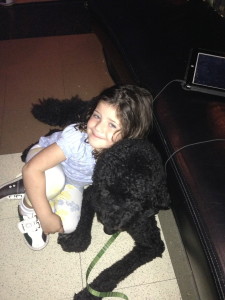 That life is passed now. With our magical invisible dog, we are filling our social calendar.
That life is passed now. With our magical invisible dog, we are filling our social calendar.
An epic summer
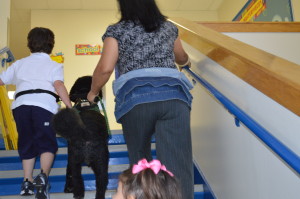 Now that school has started, it gives me a chance to reflect on our summer. Each year, as school begins, it is only natural to look at our children and consider what is different from last year. For Zoe and Lena, I begin each year with optimistic expectations of new skills and greater independence. For Gray, I generally start with a healthy dose of anxiety. This year is different, though. This year, I am buoyed by the incredible gains Gray made over a summer that was filled with both new adventures and a casual ease in activities that used to cause us so much trouble.
Now that school has started, it gives me a chance to reflect on our summer. Each year, as school begins, it is only natural to look at our children and consider what is different from last year. For Zoe and Lena, I begin each year with optimistic expectations of new skills and greater independence. For Gray, I generally start with a healthy dose of anxiety. This year is different, though. This year, I am buoyed by the incredible gains Gray made over a summer that was filled with both new adventures and a casual ease in activities that used to cause us so much trouble.
May brought its usual anxieties: trying to get the school plan hammered out for fall, working out the camps so that Gray would not be idle at home, worry over his behavior at the pool, worry over his ability to cope with summer travel. In addition, we were also fiddling with Gray’s medications to get his mood stabilized. In our attempts to smooth out his wild swings between crazed-mania and narcolepsy, we tried 4 different medications. Each one had its own bizarre side-effects and none of them really helped very much. After a severe skin reaction, a huge weight gain, full-body tremors and hair-triggered irritability, I decided to take a break from medication manipulation and see what “Baseline Gray” might look like.
We started the summer with a decision to focus his behavioral therapies on good manners in public – especially at the pool. Last year, Gray was like a wild animal at the pool. He would fly through the entrance, attempt to jump in the pool fully clothed, swim with glee and exit the pool like a bullet with an unknown target. Last summer, I sported a huge bruise for a couple of weeks after trying to make him wait at the table while I got everyone out of their cover-ups and ready to swim. Gray was so enraged, he bit me in the stomach and then wailed on the ground to the horror of everyone around me. Last summer, Gray sported numerous bruises after running up the pool steps and attempting to sprint across the pool deck only to slip and fall. Last summer, Barry and I would have to coordinate so that one person could keep Gray swimming while the other person ordered food and had it waiting on the table lest he jump out and steal other people’s french fries.
This year, we were able to build a social story to explain how we calmly walked to the entrance, paused to gather towels, settled in at a table and waited for everyone to be ready before we walked into the pool. This year, we practiced walking slowly when leaving the pool, using the iPad to request food and walking with the iPad to the snack bar to order burgers and fries. Last Friday night, as the whole family enjoyed a calm meal poolside and discussed the lovely weather that graced our week, I beamed over my sweet boy who sat nicely at the table and ate his dinner. It is truly amazing that, through the course of the summer, we have evolved to the point where going to the pool is a fun and relaxing experience for everyone.
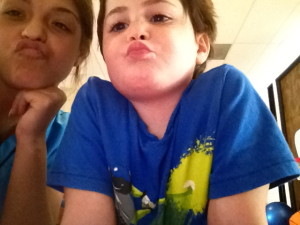
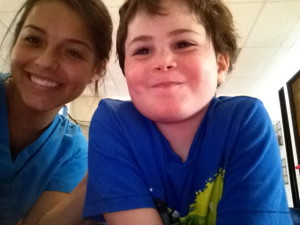 For camp, I was lucky to find a program that specializes in working with kids who are on the spectrum and use communication devices. I feel so fortunate to live in a city where a program like that exists, but I suspect that the demand for such programs is only growing with the autism rates. The sensory gym environment with multiple swings and trampolines at this camp helped to mitigate my guilt about having him structured and scheduled all summer long. In reality, Gray thrives on structure and schedule and the gym was pretty much heaven for him. I was very pleased with the staff and quality of instruction that he received there. So, the long drive was well-worth his happiness to go and the continuation of his skill-building over the summer. I am relieved to know that there is a place where Gray and Hope are welcome and accepted for school breaks in the future.
For camp, I was lucky to find a program that specializes in working with kids who are on the spectrum and use communication devices. I feel so fortunate to live in a city where a program like that exists, but I suspect that the demand for such programs is only growing with the autism rates. The sensory gym environment with multiple swings and trampolines at this camp helped to mitigate my guilt about having him structured and scheduled all summer long. In reality, Gray thrives on structure and schedule and the gym was pretty much heaven for him. I was very pleased with the staff and quality of instruction that he received there. So, the long drive was well-worth his happiness to go and the continuation of his skill-building over the summer. I am relieved to know that there is a place where Gray and Hope are welcome and accepted for school breaks in the future.
Of course, Hope attended camp with Gray each day. It’s funny because the only time the camp reported “problems” with Hope were when she was forced to be separated from him during the day. If he was on a swing, she wanted to be right next to him, not left at the edge of the gym. If he was at the snack table, she wanted to be right under him instead of outside the door. Her desire to be with her boy gave me comfort that a bond is growing between them. Even though Gray doesn’t seem to notice her beyond the handle on her service pack, I know that she sees him as her responsibility and he is comforted by her presence.
I have already written about our travel successes in my posts about our trips to Seattle and Portland, but I can’t emphasize enough how liberating it feels to know I can plan future family vacations without a pit in my stomach.
Of course, the problem with developmental disabilities is that you never really know what is helping your kid the most. If we didn’t have Gray in all of the therapies he has attended over the last 6 years, would he look the same? I doubt it, whenever professionals spend any time with him, they always comment on how well he is doing despite the severity of his autism. Is it just his development and age that have brought us to this new level of skills? That is probably a part of it. The trouble is that he doesn’t exactly show us when he is ready to move onto something new. His therapists and I just have to keep re-introducing things (like the social stories) to gauge when he is ready for them. Sometimes it works and sometimes it doesn’t.
The one thing I am sure of is that Hope has changed everything for us. Even on his worst days, we can go out in public and eat in a restaurant and walk around kid-friendly destinations because he knows what is expected of him when he is out with his dog. Overall, I firmly believe that Gray is calmer and more self-assured with Hope in his life. It’s the best medicine we could have ever found.
We are in print!
One of my favorite local magazines decided to do a story about Hope and Gray for their September issue. Today is a VERY exciting day.
Rhoni Golden and her three children claim a table at NorthPark Center’s food court to dine on Sonic. Nine-year-old Zoe and 4-year-old Lena sip blue slushies with their meals, while 7-year-old Gray sticks to his usual — a hamburger and fries.
It’s a commonplace scene, except for the black labradoodle lying calmly under the table. Dogs are not allowed at NorthPark, unless they are service dogs.
Hope is Gray’s “anchor” when the Goldens go out. Photo by Danny FulgencioHope is the labradoodle’s name, and she is tethered to Gray. Golden wouldn’t brave this seemingly mundane trip to Sonic without the dog, “considering how autistic my son is.”
“My husband says I should emphasize the words ‘mentally handicapped’ — severely,” Golden says. “My son does not speak, is not completely potty trained and just this morning, I had to clean poop off the walls of his room.”
Life is anything but mundane for the Golden family, who live in Lakewood Hills. Rhoni Golden and her husband, Barry, learned their second child had autism when he was 19 months old. A physical therapist herself, Golden immediately placed him in therapy, believing that it would “fix” Gray enough to ready him for a mainstream kindergarten classroom.
By the time Gray was 4, and still not talking, Golden’s dreams of a “normal” life for her son were shattered.
As long as Gray could be strapped into a stroller, the Goldens could go to the park or out to dinner without too much disturbance. That ended around the time he turned 5.
“We rarely go anywhere as a complete family. It’s just pretty much impossible,” Golden said earlier this year. “I’ve been with Gray at the park when he’s run out of the park and sat down in front of a moving car. Once I checked email for a couple of minutes, then ran through the house screaming his name to find out he’d run outside and was playing in the sprinkler naked.”
Then Hope entered their lives.
The family didn’t name the dog, and when Golden first learned her name, she found it a little sappy. But Hope has lived up to her moniker.
Autism service dogs are a fairly new innovation. The organization that trained Hope, Autism Service Dogs of America (ASDA), was founded in 2002 and was the first to specialize in training dogs for people with autism, says Kati Wolfe, ASDA’s placement training director and autism specialist, as well as Hope’s trainer.
A “Today” show episode introduced the Goldens to autism service dogs last fall, and by February, Rhoni Golden was on a plane to Portland, where she spent a few days of intensive training with Hope before bringing her home to Dallas.
Hope is only the second autism service dog in Texas; one other resides in Austin, Golden says. The labradoodle was an $18,000-plus investment, one that Golden is so grateful her family could afford because she believes Hope is worth every penny.
Where Gray Golden, a 7-year-old boy with severe autism, goes, so does his service dog, Hope. Photo by Danny FulgencioPerhaps the hardest consequence of autism is loneliness, not only because few others understand the situation but also because of the self-induced confinement.
“People tell me they don’t see many other kids like Gray, and I say, ‘Well, they don’t go out,’ ” Golden says. “I think a lot of people feel sort of shamed.”
Gray, especially when he is in unfamiliar settings, can become overwhelmed by sounds, noises and crowds, “which causes him to go into tantrums, to throw himself to the ground, and he might lash out at others,” Wolfe says.
“Children with autism are losing everyday skills of how to access their community, how to go into a restaurant and be quiet, because they are isolated,” Wolfe says, “and when you isolate, you build fear.”
Hope changes this dynamic. On the trip to Sonic, Golden attaches Gray’s belt to the service pack on Hope’s back as soon as they step out of the car.
“She’s an anchor for him,” Golden says, with four feet of tether acting as Gray’s boundaries. He approaches the mall holding a handle on Hope’s pack, as he has been taught, and maintains this stance most of the time. If Gray starts to unravel, Hope stands firm, and Golden, who holds the dog’s leash, feels the tugging and quickly reacts to steady her son.
“Without Hope here right now, Gray would probably be running around stealing fries off people’s plates, or running down the escalator with me shoving people out of the way trying to get to him,” she says.
Hope has changed the lives of Zoe and Lena just as drastically. Between tater tots, Zoe exclaims her excitement that her family can now go to movies together or pull in to TCBY on a whim, she says, and even vacation together.
“I want to have some time with my family — not just mom or just dad,” Zoe says. “We can go out with Gray now because of Hope.”
It has cost Zoe to have a brother like Gray. Until Hope, she was limited on what she could do socially by whether her family could find a babysitter (not an easy task with an autistic child) and invitations from friends, “and you can’t just say, ‘Hey, invite me over,’ ” Zoe says. Despite this, she views herself as her brother’s protector and caretaker, and ardently defends him.
“Other people think of him as horrible and bad. They don’t understand him,” Zoe says. “Some autistic children, they can’t love. Gray, I know he loves me.”
She mimics the way he tells her this — “I uh yooou.” She also knows by the way he tackles her, one of Gray’s forms of hugging. It pains Zoe that she can talk to Gray only through an iPad with a special app that turns it into a speaking device. The app allows Gray to communicate about things like what he wants to eat.
“He has a nice voice on his iPad, but I want to hear his voice,” Zoe says. “What I’ve taught my little sister is, ‘You and me are Gray’s sisters, and we take good care of him, and we will make him talk.’ ”
“Me and Zoe will help Gray,” Lena echoes.
And now that Hope is part of the family, she is Gray’s protector, too, Zoe says.
“She’s holding him, she’s taking care of him,” his big sister observes. “She wouldn’t let him run down the aisles and scream and pull people’s hair and hurt people.”
When Gray is untethered at home, he sometimes goes to Hope to pet her, and makes cooing noises, Zoe says. “I can tell he loves Hope,” she says.
The whole family has fallen head over heels for the labradoodle. Golden emphasizes that Hope is not a pet, but sometimes has to remind her children. On the walk to Sonic, Lena affectionately throws her arms around Hope and her mother chastises, “Lena, no, she’s working.”
Hope seems unfazed, however, and Gray continues calmly walking beside her.
“He stops and looks around a whole lot more,” Golden says. “Before the dog, he was so focused on moving, going, getting to the next destination. He didn’t focus on his environment at all.”
It would be easier for the Golden family to do what many families with a severely autistic child do — hole up at home, and deal with the challenges privately rather than having to deal with the frustrations and embarrassments that inevitably happen in public. But that was never an option.
Golden describes herself as an “open book — it doesn’t occur to me to hide anything.” When she realized the extent of Gray’s autism years ago, she quit her job as a physical therapist to focus on her family. But when she was helping patients, “my attitude to them was always, ‘Live your life. Go make the best of it.’ ”
She has adopted the same mantra for herself and her family, and for the most part, “everybody is rooting for us. Everybody wants to hear the happy ending about the disabled kid who gets to go out and live a normal life,” Golden says. On a few occasions, however, the Goldens have had to defend Hope’s right to be in public places.
Gray is a first-grader this year, and because of Hope, the Goldens felt confident enough to move him from Oak Hill Academy to Dallas ISD’s John F. Kennedy Learning Center near Ross and Henderson. When they tried to enroll Gray, DISD’s legal department fought them, saying the district could not provide a handler for Hope. The district thought an aide for Gray would be enough, Golden says, but she insisted otherwise.
“Wherever my son goes, the dog goes,” Golden says. “With autism, it’s gotta be consistent. It’s all or nothing.”
The Goldens were backed up by a precedent of successful federal suits involving autism service dogs, as well as by the principal and teachers at JFK, Golden says. The district eventually agreed that Gray’s aide also could be Hope’s handler.
So on May 30, Hope became the first service dog to attend a DISD school.
The Goldens know new challenges will arise as Gray grows older and bigger. One of the worst characteristics of autism is the tendency to assault strangers, Golden says, and “teenage assaults are worse than little kid assaults.”
She tends to live in the present, however, taking one day at a time. Thanks to Hope, the living is easier these days — most importantly for Gray, Golden says.
“I don’t know what life holds for him in the future,” she says, “but right now, while he’s living under my roof, I’m going to make sure he has the best life possible.”
To read about the Golden family’s challenges and victories with Hope at their side, visit hopeforgray.com. While there, click on “donate” in the navigation bar to make a contribution the “Hope for Gray” fund started by the Goldens to increase the number of children who can benefit from a dog like Hope.
– See more at: http://lakewood.advocatemag.com/2013/08/27/first-dallas-isd-service-dog-aids-lakewood-familys-autistic-child/

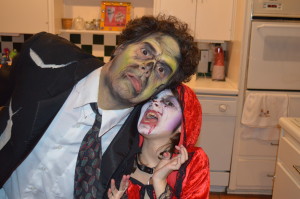
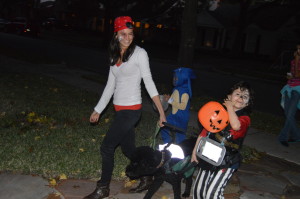
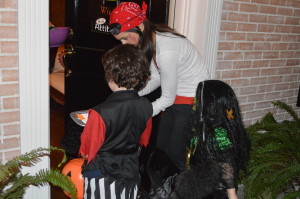

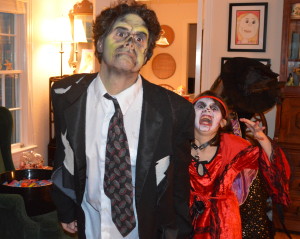
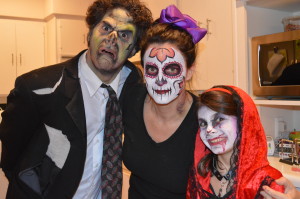

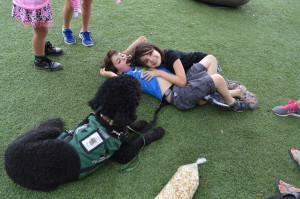




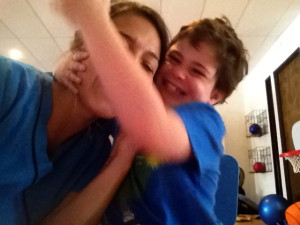

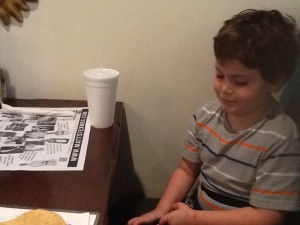
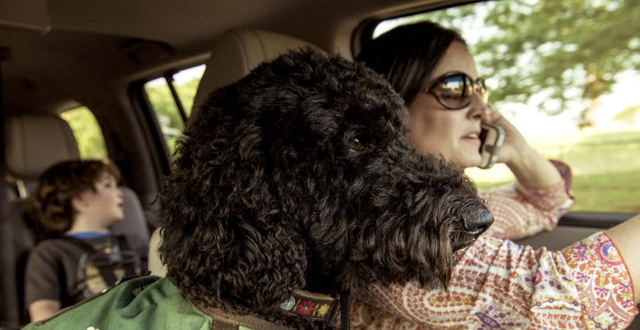
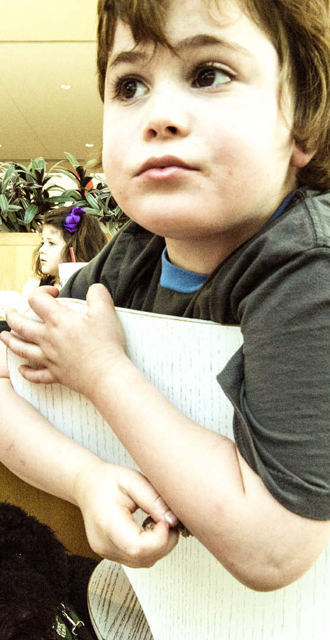
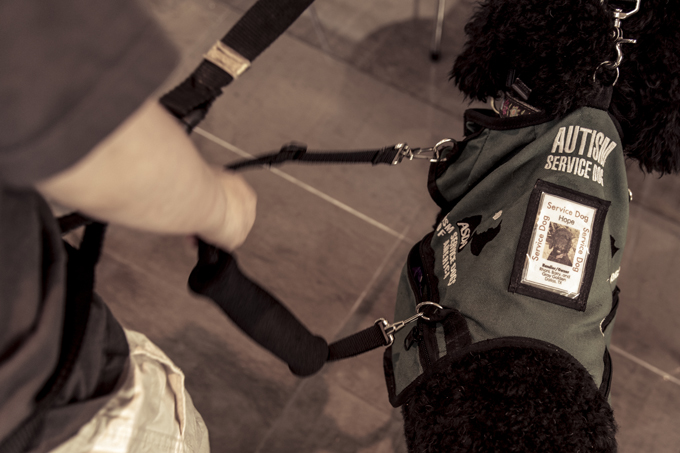
Recent Comments